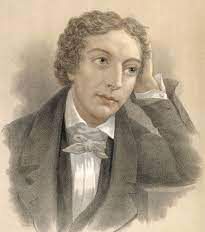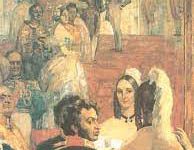The Love of John Keats
John Keats
The Love of John Keats
John Keats (1795-1821) was one of the great English Romantic poets. As a poet, he was a wonder—because he was the only poet, in the whole range of English poets, who had been living for a span of only twenty-five years and within the brief span of life he had composed some poem of an exquisitely grand and superior kind. His poems are full of sensuous imagery. To say in other words, his poems are the garlands of rainbow-like imageries and imageries which impact our senses more than intellect. Through his poems, he glorifies the inner beauty of things. “Beauty is truth, truth beauty” was the motto of almost all his poems. In the making of imageries, he had no rivals except only William Shakespeare, in the whole list of not only English poets but of the world poets.
The personal life of this wonderful great poet was full of sorrow and suffering. John Keats lost his father at the age of eight, his mother at the age of sixteen and his brother at the age of nineteen which filled his tender heart up with woe and sorrow. After his father’s death, he fell into poverty which cast him into the drain of hunger. Thirdly, his poems faced adverse criticism from some contemporary critics which broke down the spirit of his heart. Fourthly, he had been suffering from his childhood, from constant disease and often he was threatened with death by consumption. And the finale, it was his affair of passionate love with a woman that added to his sorrow and sufferance more and more and at last, his sufferance sent him to premature death.
Love to him was, first a source of life and secondly, a source of sufferance and death. His love was less physical but more mental. In the prime of his youth, he came into contact with a girl whose name was Miss Jane Cox. His love for her was physical and it affected his sensual desire more than spiritual attraction. She was beautiful, no doubt, but she could not share his personal likes and dislikes and soon the love affair came to an end.
His second love affair was with Mrs. Isabella Jones. But this affection, between the two, was not deep. They love each other for a time being, and soon they got separated.
His third significant but deep love was with a girl whose name was Miss Fanny Browne. She was the sister of one of his friend cum patrons named Charles Browne. The poet, after losing his parents and brother, went on a tour to Scotland in 1818 to lessen the depth of his sorrow and woe. But he could not bear the pangs of loneliness that he felt after his brother’s death. So he went to Wentworth Place in Hampstead to live with his friend Charles Browne. There the poet met Miss Fanny Browne. At their first meeting, they seemed to like each other and then it developed into love. She was, to the eyes of the poet, “beautiful, elegant, graceful, silly, fashionable and strange.” At that time she was a girl of seventeen, full of youthfulness. Her physical beauty attracted both his sensitive eyes and tender heart. For some days, they played and walked about here and there together. Their sense of love for each other deepened. In the meantime, John Keats’ life-long disease of consumption began to sour up. On the other hand, his long poem Endymion, published in 1818, faced adverse and even vehement criticism that enfeebled his spirit. The higher tragedy of the poet began to grow serious. In early 1820, John Keats was continually ill. He caught a chill and had a hemorrhage of the lungs and palpations of the heart. He was haunted by the thought of death. By this time he desired most to enter into the bond of marriage with Fanny Browne. But he did not dare to propose to her because of his growing illness. Fanny Browne also seemed to keep herself away from him. She declined the intention of marrying him. The poet’s broken heart began to grow worse. But his love for her remained the same as it was at the beginning. He with heart and soul desired her touch, but marriage between them began to grow impossible. Then his love to Fanny aspired to a spiritual one. He, eventually, gave up the idea of marrying her, but he could not cease to love her. He wrote in a letter to his friend, “I can bear to die—I cannot bear to leave her.” Though Keats was unable to marry her physically, yet he always hoped Fanny to remain his beloved forever. He wanted her not to get married to anyone else. Though he was disappointed in love, yet he did not give up writing poetry. The memory of Fanny inspired him to run on his writing. In a letter to Fanny, he wrote:
“— you do not feel as I do—you do not know what it is to love—one day you may—your time is not come.”
This quoted line shows how passionate and deep his love to Miss Fanny Browne was!
At the same time, John Keats fell into extreme misery. He wrote to Fanny:
“… O, Browne. I have coals of fire in my breast. It surprised me that the human heart is capable of containing and bearing so much misery.”
In September 1820, his doctor examined his disease and presaged his approaching death and so he advised him to go to Italy for a change of climate. Obeying the doctor’s advice, he along with his truthful and sympathetic friend Joseph Severn, sailed to Italy. He went to Rome in November 1820. He was then longing for death because his inner self realized that he would not recover from his illness. The doctors of Rome made him bleed and put him on a starvation diet. His condition became serious by January 1821. The reminiscence of Fanny Browne added fuel to the fire of suffering and after suffering a constant fear of death his soul went out of his mortal body to the other world. In one of his poems, Ode on a Grecian Urn he expresses his philosophy of love as,
“More happy love! more happy, happy love!
Forever warm and still to be enjoy’d
Forever panting and forever young.” 0 0 0
John Keats
N.B. The article ‘The Love of John Keats’ originally belongs to the book ‘Love of Reputed Persons‘ by Menonim Menonimus.
John Keats
Books of Composition by M. Menonimus:
- Advertisement Writing
- Amplification Writing
- Note Making
- Paragraph Writing
- Notice Writing
- Passage Comprehension
- The Art of Poster Writing
- The Art of Letter Writing
- Report Writing
- Story Writing
- Substance Writing
- School Essays Part-I
- School Essays Part-II
- School English Grammar Part-I
- School English Grammar Part-II..
Books of S. Story by M. Menonimus:
Related Search:
- 25 Best Love Quotes
- Greatest Real-Life Love Stories
- Psychology of Love
- Beautifully Written Love Stories
- The Secret Lives of Writers











